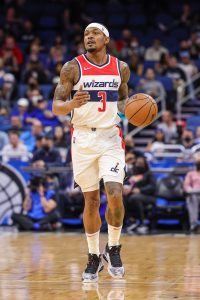Hoops Rumors is in the process of taking a closer look at each NBA team’s current roster situation, evaluating which clubs still have some moves to make and which ones seem most prepared for training camp to begin.
This series is meant to provide a snapshot of each team’s roster right now, so these articles won’t be updated in the coming weeks as more signings, trades, and cuts are made. You can follow our roster counts page to keep tabs on teams’ open spots as opening night nears.
We’re continuing our pre-camp Roster Snapshot series today with the Atlantic Division. Let’s dive in…
Boston Celtics
- Players on guaranteed standard contracts: 11
- Players on non-guaranteed standard contracts: 3
- Dalano Banton ($200K partial guarantee), Svi Mykhailiuk ($200K partial guarantee), Luke Kornet
- Players on Exhibit 10 contracts: 1
- Players on two-way contracts: 3
- Players who have reportedly reached contract agreements: 1
- DJ Steward (training camp)
No team has fewer players on guaranteed contracts than the Celtics, but Boston doesn’t necessarily need to make any more roster additions. Simply hanging onto Banton, Mykhailiuk, and Kornet to start the season would give the club a 14-man roster and an open 15-man slot to maximize flexibility.
If the Celtics have any doubts about Banton and Mykhailiuk, they’ll probably want to make a decision on them by opening night — both players will have their partial guarantees increase to $1MM+ if they’re not waived before the start of the regular season.
Brooklyn Nets
- Players on guaranteed standard contracts: 13
- Players on non-guaranteed standard contracts: 2
- Players on Exhibit 9 contracts: 1
- Players on Exhibit 10 contracts: 2
- Players on two-way contracts: 2
- Players who have reportedly reached contract agreements: 1
- Patrick Gardner (training camp)
At this point, the Nets seem likely to let Bazley, Watford, and Giles – three frontcourt players – vie for the two openings on the 15-man roster to start the season. Hall, Sykes, and Gardner figure to end up in the G League with Long Island, but if one of them (or another camp invitee) impresses in camp, he could have his contract converted into a two-way deal.
Giles remains eligible for a two-way contract despite having four years of NBA experience, since he missed a full season due to an injury. But his Exhibit 9 contract can’t be directly converted into a two-way deal, so the Nets would have to waive him and re-sign him if they want him to fill their final two-way slot.
New York Knicks
- Players on guaranteed standard contracts: 12
- Players on non-guaranteed standard contracts: 2
- Players on Exhibit 9 contracts: 2
- Players on Exhibit 10 contracts: 2
- Players on two-way contracts: 3
The Knicks have the flexibility to add another free agent or two on a guaranteed contract, but have shown no urgency to do so and may end up starting the season with two or three players on non-guaranteed salaries filling out the back of the roster.
Jeffries, Roby, Arcidiacono, and Washington are in the mix for those spots. I wouldn’t bet against Arcidiacono, who made the Knicks’ regular season roster despite being being on a non-guaranteed deal in both 2021 and 2022.
Philadelphia 76ers
- Players on guaranteed standard contracts: 13
- Players on non-guaranteed standard contracts: 2
- Filip Petrusev ($560K partial guarantee), Danny Green
- Players on Exhibit 10 contracts: 2
- Players on two-way contracts: 3
- Players who have reportedly reached contract agreements: 2
- Kelly Oubre, Marcus Bagley (training camp)
With Harden’s trade request still pending, the Sixers’ roster could look quite different in a month than it does now. On the other hand, there’s no indication that the Harden trade talks have been all that active lately, so perhaps he’ll remain in Philadelphia for the foreseeable future.
If the roster doesn’t undergo additional changes, the 76ers will have to decide who the odd man out on the 15-man roster is. The team is signing Oubre to join a group of 13 players on guaranteed contracts, plus Petrusev and Green. There would be room for both Petrusev and Green if Philadelphia decides to trade or release one of the players who has a guaranteed deal — Harrell, who is expected to be out all season with an ACL tear, would be a prime candidate.
Toronto Raptors
- Players on guaranteed standard contracts: 15
- Players on non-guaranteed standard contracts: 1
- Players on Exhibit 10 contracts: 2
- Players on two-way contracts: 3
Dowtin played well for the Raptors down the stretch in a backup point guard role last season, but could be on the outside looking in this fall, given that the team is carrying 15 players on guaranteed salaries.
If Dowtin shows in camp and the preseason that he deserves a place on the 15-man roster, it may not bode well for one of the veterans on an expiring contract who’s not necessarily assured of a rotation role — Flynn, Temple, Young, and Porter could all fall into that group.
Previously:

 Currently,
Currently,  Suns star
Suns star  A
A